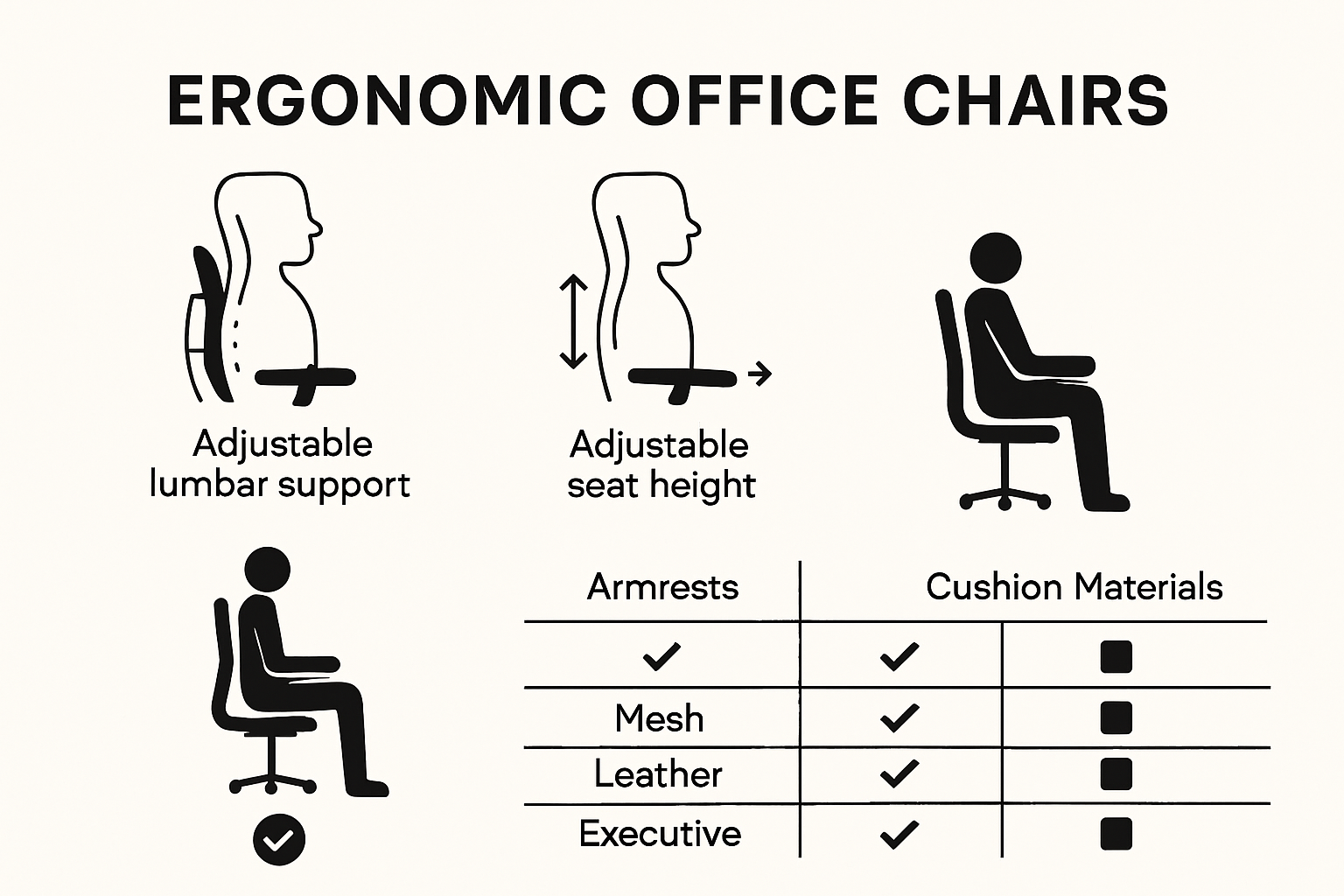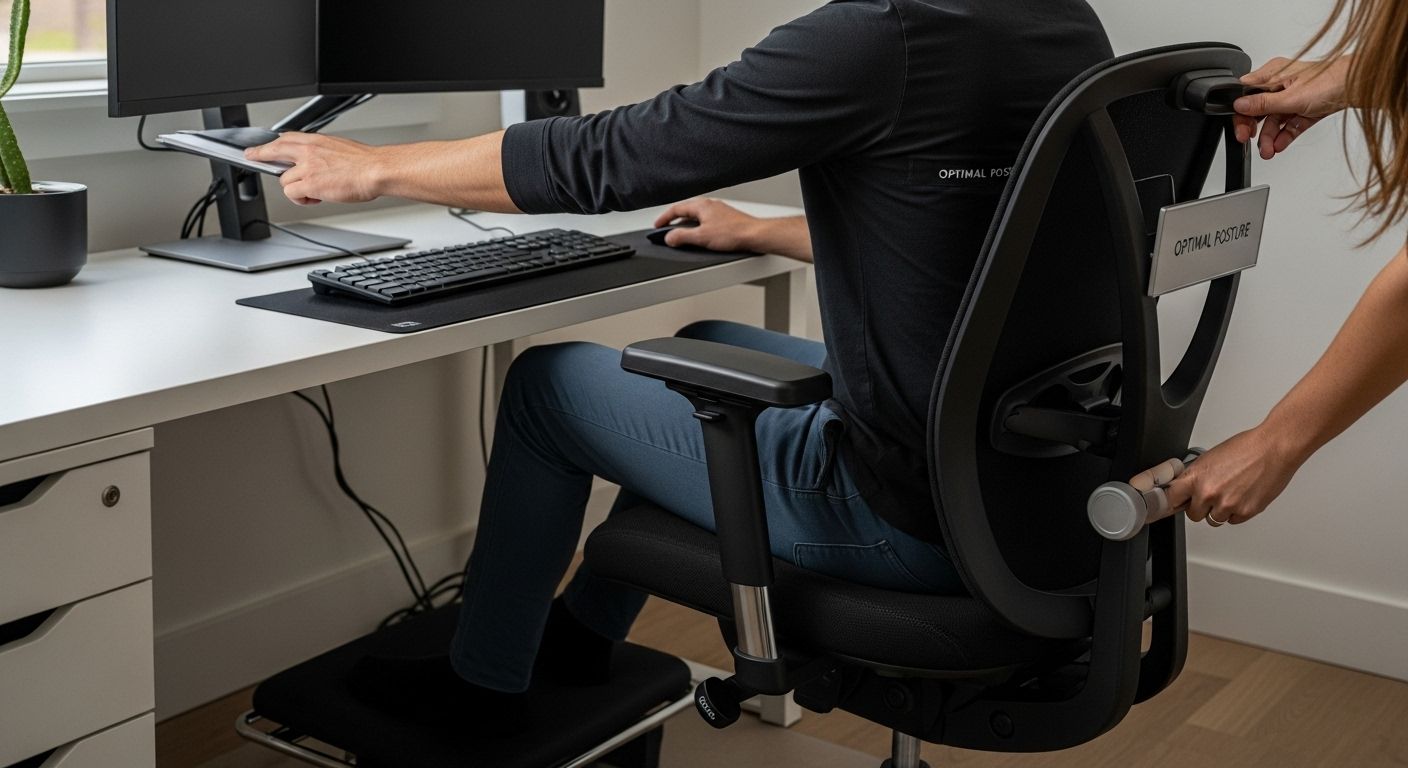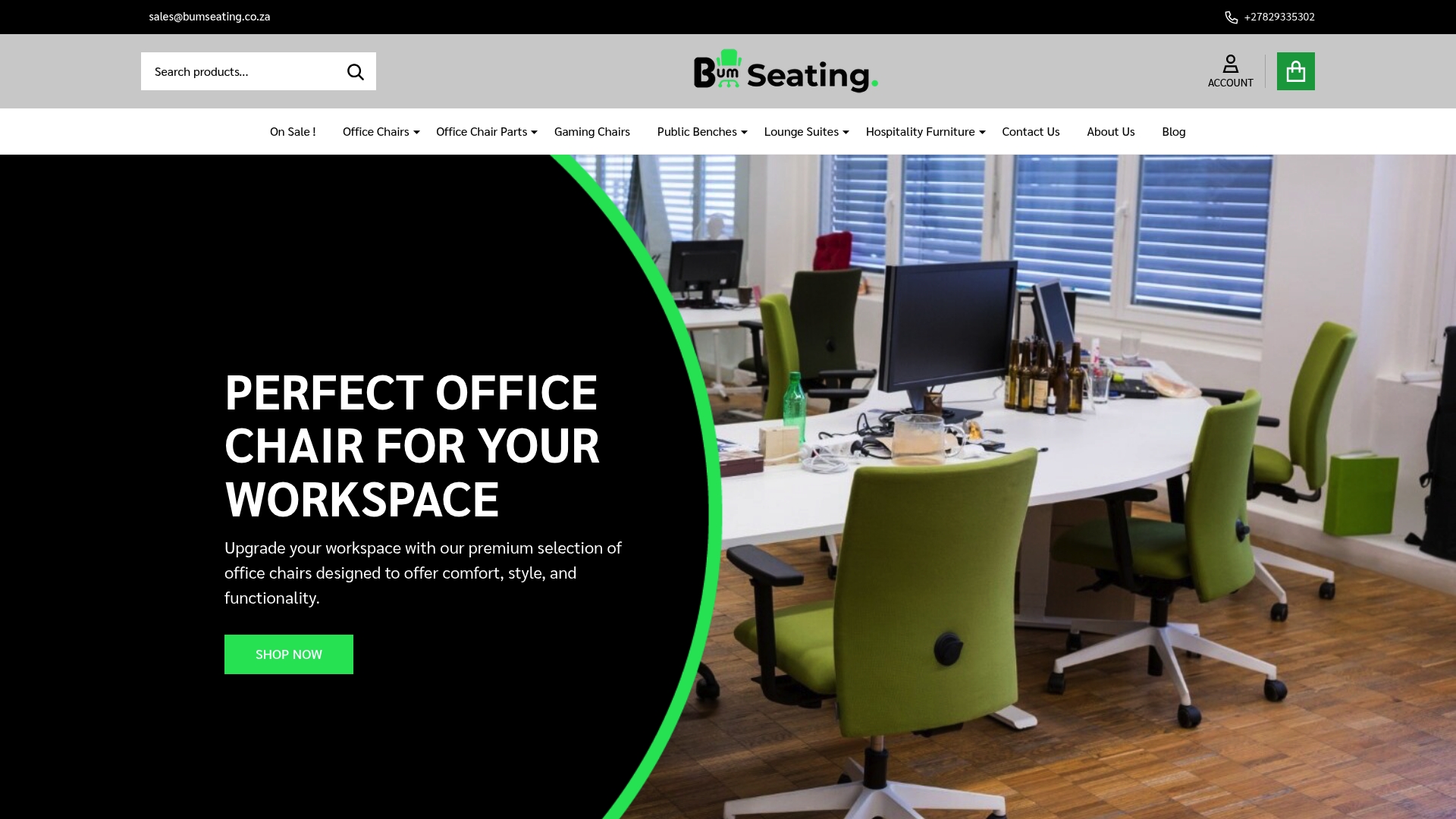Optimize Office Seating for Posture in Your Workspace
22nd Aug 2025
Optimize Office Seating for Posture in Your Workspace

Office seating choices can make or break your workday comfort. Studies show that people spend up to 8 hours a day sitting at their desks, and poor seating is linked to a sharp rise in back pain and reduced productivity. But most folks think a fancy chair or a quick cushion swap will fix everything. The real secret lies in small, methodical tweaks and regular check-ins that totally reshape how your body feels at work.
Table of Contents
- Step 1: Evaluate Your Current Office Seating Setup
- Step 2: Identify The Key Features For Ergonomic Chairs
- Step 3: Select Appropriate Office Seating For Your Needs
- Step 4: Arrange And Adjust Your Workspace For Optimal Posture
- Step 5: Test Your New Setup For Comfort And Support
- Step 6: Implement Regular Re-Evaluations And Adjustments
Quick Summary
| Key Point | Explanation |
|---|---|
| 1. Conduct a thorough chair evaluation | Assess your existing chair for wear and support features before making any changes. |
| 2. Prioritise adjustable lumbar support | A good ergonomic chair should effectively support your lower back without discomfort or rigidity. |
| 3. Test chairs in person for fit | Sit in potential chairs for at least 10-15 minutes to evaluate comfort and support during typical work activities. |
| 4. Configure your workspace strategically | Align your chair and monitor properly to maintain healthy posture and prevent strain. |
| 5. Schedule regular ergonomic assessments | Re-evaluate your workspace every few months to adapt to changing needs and prevent discomfort. |
Step 1: Evaluate Your Current Office Seating Setup
Understanding your current office seating setup is the critical first step in optimising your workspace for better posture and overall comfort. At Bum Seating, we recognize that most people spend countless hours sitting, which makes a comprehensive seating evaluation crucial for preventing long-term health issues and improving workplace productivity.
Begin by conducting a thorough physical assessment of your existing chair. Stand back and observe how the chair supports your body. Look for visible signs of wear, such as flattened cushions, unstable bases, or damaged armrests which might compromise your seating ergonomics. Pay special attention to how your current chair responds to your body’s natural movements and whether it provides adequate support across different sitting positions.
Carefully examine the chair’s adjustability features. Explore our comprehensive seating guide to understand the critical adjustment points. Check if your chair allows height modification, backrest tilt, and armrest positioning. Sit in the chair and systematically test each adjustment mechanism. Note which features work smoothly and which feel restrictive or difficult to manipulate.
According to Cornell University’s Ergonomics Research, a proper seating evaluation involves measuring key ergonomic parameters. Use a measuring tape or ruler to assess the relationship between your body and the chair. Verify that when seated, your feet rest flat on the floor, your knees form a 90-degree angle, and your lower back receives consistent support. These measurements will serve as a baseline for understanding your current seating’s effectiveness and identifying potential improvements.
The goal of this evaluation is not just identifying problems but creating a clear roadmap for enhancing your workspace comfort. Document your findings through photographs or written notes, capturing the chair’s current condition and your body’s interaction with it. This documentation will prove invaluable when selecting a new chair or making targeted ergonomic adjustments.
To help you assess your current office chair effectively, use this checklist to verify each key ergonomic criteria and record your observations.
| Assessment Criterion | What to Check | Your Notes |
|---|---|---|
| Cushion Condition | Flattened or worn areas | |
| Base Stability | Any wobbling or damage | |
| Armrest State | Damaged or unstable | |
| Height Adjustability | Easy to change seat height | |
| Backrest Function | Smooth tilt and support | |
| Feet Position | Flat on the floor when seated | |
| Knee Angle | 90-degree angle at knees | |
| Lumbar Support | Consistent lower back support | |
| Documentation | Take photos or write notes |
Step 2: Identify the Key Features for Ergonomic Chairs
Now that you have evaluated your current seating setup, understanding the essential features of an ergonomic chair becomes paramount for improving workplace posture and comfort. At Bum Seating, we recognize that selecting the right chair involves more than aesthetic appeal—it requires a strategic approach to supporting your body’s natural alignment and movement.
Lumbar support represents the cornerstone of ergonomic chair design, providing crucial lower back protection during extended sitting periods. Look for chairs with adjustable lumbar support that can be fine-tuned to match your spine’s unique curvature. The support should feel like a gentle, consistent embrace that maintains your natural spinal position without creating pressure points or discomfort. When testing potential chairs, pay attention to how the lumbar region feels—it should provide support without feeling rigid or restrictive.
Discover comprehensive chair selection strategies that go beyond basic features. According to OSHA’s Ergonomic Guidelines, critical chair features include adjustable seat height, seat depth, and armrest positioning. Ensure the chair allows you to sit with your feet flat on the floor, knees at a 90-degree angle, and forearms parallel to the ground. Seat width and depth matter significantly—the chair should accommodate your body without forcing you to perch on the edge or sink too deeply into the cushion.
Consider the chair’s material and cushioning as well. Breathable fabrics like mesh can help regulate body temperature, while high-density foam provides consistent support without breaking down quickly. Test the chair’s mobility by checking the base and wheels—they should allow smooth movement without compromising stability. Remember that an ergonomic chair is an investment in your health and productivity, so take time to evaluate each feature methodically. Your goal is finding a chair that adapts to your body, not forcing your body to adapt to an uncomfortable seating solution.

Step 3: Select Appropriate Office Seating for Your Needs
With a clear understanding of your current seating setup and the key ergonomic features, you are now ready to select the most appropriate office chair that matches your unique physical requirements and work environment. At Bum Seating, we recognize that choosing the right chair is not a one-size-fits-all solution but a personalized decision that impacts your daily comfort and long-term health.
Body measurements and work style play a crucial role in chair selection. Consider your height, weight, and typical daily activities when evaluating potential chairs. Taller individuals might require chairs with extended backrests, while those who frequently switch between sitting and standing would benefit from chairs with more dynamic support mechanisms. Learn more about matching chairs to your workspace to make an informed decision that goes beyond basic aesthetics.
According to research from UCLA’s Ergonomics Department, precise measurements are essential when selecting an ergonomic chair. Measure the distance from the floor to the back of your knee to determine the ideal seat height, and ensure that the seat depth allows a two-finger width gap between the seat edge and the back of your legs. Test chairs in person whenever possible, paying attention to how the chair responds to your body’s natural movements. Sit for at least 10-15 minutes in each potential chair, simulating your typical work postures and movements to gauge true comfort and support.
Consider your specific work environment and potential future needs. A chair that works perfectly in a home office might not suit a dynamic corporate setting. Factor in additional features like swivel capability, wheel type, and fabric durability. Some chairs offer modular designs that allow component upgrades, providing flexibility as your workspace and personal requirements evolve. Remember, investing in a high-quality ergonomic chair is an investment in your health, productivity, and overall workplace well-being.
Step 4: Arrange and Adjust Your Workspace for Optimal Posture
Having selected the right ergonomic chair, the next critical step is creating a workspace that supports and enhances your newly optimized seating arrangement. At Bum Seating, we understand that chair selection is only half the battle—strategic workspace configuration is equally crucial for maintaining proper posture and preventing long-term physical strain.
Positioning your chair in relation to your workstation requires precision and thoughtful consideration. Begin by aligning your chair’s height so that your feet rest flat on the floor, with knees positioned slightly below hip level. If your feet do not comfortably reach the floor, invest in an adjustable footrest to maintain proper leg positioning. Explore our comprehensive workspace setup recommendations to understand the nuanced details of ergonomic positioning.
According to Washington State University’s Ergonomics Guidelines, monitor placement is fundamental to maintaining correct posture. Position your screen directly in front of you, with the top of the monitor at or slightly below eye level, and approximately an arm’s length away. This strategic placement prevents neck strain and reduces the likelihood of developing repetitive stress injuries. Your keyboard and mouse should be positioned to keep your wrists straight and elbows close to your body, forming an open angle between 90 and 110 degrees. Consider using ergonomic keyboard trays or adjustable desk surfaces to achieve optimal alignment.
Remember that even the most perfectly arranged workspace requires regular movement. Set reminders to stand, stretch, and change positions every 30-45 minutes. Incorporate small adjustments like slightly shifting your chair, performing seated stretches, or taking brief walking breaks to promote circulation and prevent muscle stiffness. Your workspace should be a dynamic environment that adapts to your body’s needs, not a static setup that forces your body into uncomfortable, unnatural positions.

Step 5: Test Your New Setup for Comfort and Support
With your workspace carefully configured, the final step involves thoroughly testing your new ergonomic setup to ensure it provides the optimal comfort and support you need. At Bum Seating, we understand that true ergonomic success goes beyond initial setup—it requires careful observation and fine-tuning to match your body’s unique requirements.
Systematic testing is crucial for identifying potential adjustments and ensuring long-term comfort. Start by sitting in your newly arranged workspace for extended periods, paying close attention to how your body responds. Monitor key physical indicators such as muscle tension, pressure points, and any emerging discomfort. The first few days are critical—your body will be adapting to the new configuration, so maintain heightened awareness of how you feel during different work activities. Explore our detailed comfort assessment guide to understand subtle signs of proper ergonomic alignment.
According to the University of North Carolina’s Ergonomics Research, a comprehensive setup test should involve multiple scenarios. Simulate your most common work tasks—typing, reading, using multiple monitors, or participating in video conferences. Pay attention to how your chair supports you during these varied activities. Make incremental adjustments to chair height, backrest angle, and armrest positioning. Keep a daily comfort journal noting any persistent discomfort, areas of tension, or physical strain. This documentation will help you make precise modifications and track your body’s adaptation to the new workspace configuration.
Remember that ergonomic optimization is an ongoing process. What feels comfortable today might require slight adjustments in the coming weeks. Schedule regular self-assessments, ideally every two to three weeks, to ensure your workspace continues to support your physical well-being. Be patient with yourself and willing to make small, thoughtful modifications. Your goal is creating a dynamic workspace that evolves with your body’s changing needs, promoting long-term comfort and preventing potential workplace-related physical strain.
Below is a summary of each step in the office seating optimisation process, along with key actions and intended outcomes for quick reference.
| Step | Key Action | Intended Outcome |
|---|---|---|
| 1. Evaluate Current Seating | Physical chair assessment, measurements | Identify needs and baseline comfort |
| 2. Identify Ergonomic Features | Review lumbar, adjustability, materials | Know what features to look for |
| 3. Select Suitable Chair | Match chair to body/work style, test usage | Find the best chair for your needs |
| 4. Arrange/Adjust Workspace | Position chair, monitor, keyboard, mouse | Encourage healthy posture |
| 5. Test for Comfort and Support | Use workspace, monitor for discomfort | Confirm setup supports your body |
| 6. Regular Re-evaluations | Schedule assessments, note changes | Maintain ongoing ergonomic health |
Step 6: Implement Regular Re-evaluations and Adjustments
Ergonomic optimization is not a one-time event but a continuous process of adaptation and refinement. At Bum Seating, we recognize that your body and work environment are dynamic, requiring periodic reassessment to maintain optimal comfort and support. Regular re-evaluations ensure that your workspace evolves alongside your changing physical needs and professional demands.
Create a structured schedule for systematic workspace assessments, treating your ergonomic setup like a preventative health maintenance plan. Mark your calendar for comprehensive reviews every three to six months, or more frequently if you experience significant changes in work patterns, physical condition, or workspace configuration. These scheduled evaluations prevent gradual posture degradation and help you catch potential discomfort before it develops into chronic issues. Discover our comprehensive workspace monitoring strategies to maintain long-term ergonomic health.
According to the National Institutes of Health’s Ergonomic Assessment Guidelines, professional self-assessment involves more than physical measurements. Document changes in your physical comfort, noting any emerging tension points, reduced mobility, or recurring discomfort. Pay attention to subtle shifts in your body’s response to your workspace—changes in sleep quality, muscle stiffness, or energy levels can indicate the need for ergonomic adjustments. Consider keeping a digital or physical journal tracking these observations, creating a personal health and comfort baseline that allows you to make informed, proactive modifications.
Remember that ergonomic optimization is a personalized journey. As your work demands, physical condition, and workspace evolve, so too should your approach to comfort and support. Stay curious, attentive, and willing to make incremental changes. Your goal is creating a dynamic, responsive workspace that supports your well-being, promotes productivity, and adapts to your body’s changing needs throughout your professional journey.
Take Your Workspace to the Next Level with Genuine Ergonomic Solutions
You have just learned how critical the right office chair and workspace layout are for maintaining healthy posture and long-lasting comfort. If you have noticed discomfort, poor concentration, or ongoing tension during your workday, it is time to act. The article clearly shows that simple adjustments or a new ergonomic chair can help you avoid chronic pain and boost your daily productivity.

Upgrade your office chair and transform the way you feel at your desk. Visit Bum Seating for quality-tested ergonomic chairs, detailed product images, and a catalogue of modern seating solutions made for South African workspaces. Ready to discover your ideal fit? Explore our latest ergonomic office chair options and make comfort your new standard. Do not wait for problems to become permanent. Shop today and enjoy a workspace that truly supports you.
Frequently Asked Questions
What are the key features to look for in an ergonomic office chair?
Look for adjustable lumbar support, seat height, seat depth, and armrest positioning. The chair should support your natural spinal alignment and allow for fluid movement.
How can I evaluate if my current office chair is suitable for my posture?
Conduct a physical assessment of your chair, checking for signs of wear and testing its adjustability features. Ensure your feet rest flat on the floor and your knees form a 90-degree angle when seated.
How should I arrange my workspace after selecting an ergonomic chair?
Position your chair so that your feet rest flat on the floor, and your monitor is at or slightly below eye level, about an arm’s length away. Ensure your keyboard and mouse are close enough to keep your wrists straight and elbows at a 90-degree angle.
How often should I re-evaluate my ergonomic workspace setup?
Schedule regular assessments every three to six months, or more frequently if you notice changes in your comfort or work patterns. This helps ensure your workspace continues to support your physical well-being.
